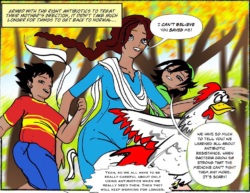Outputs and Impacts: Supporting Evidence-Based Policy
Outputs so far
Over the course of this project, we have conducted over 500 household-level interviews with livestock-keepers in India and Kenya. This has generated new knowledge about access to antibiotics for both livestock and humans within these communities, as well as new understanding of healthcare seeking behaviours and attitudes to healthcare professionals among community members. Comparison of this data with previous datasets has enabled us to identify longitudinal changes within the same communities, revealing substantially increased accessibility of antimicrobials now compared with twenty years ago, coupled with very variable access to healthcare professionals, particularly for animals. In many of the communities studied in Kenya, antimicrobials are available without prescription from ‘Agrovet’ livestock drug stores, which are now present in far greater numbers than in an initial study conducted in 1999. This has significant implications for development of AMR and provides evidence to support new policies aimed at reducing AMR in both countries.
The data gathered also provides critical information about the drivers underlying use of antimicrobials and the key risk factors for emergence and spread of AMR. We have used these findings to develop a metric to explore the risk of AMR emergence at the community level. The metric assigns scores to a range of risk factors related to the use of antibiotics from the priority livestock disease present within communities, to excessive or extra-label use, improper disposal and the mixing of herds, for example at shared water sources. The metrics calculates a total ‘risk score’ for each community, which underpins an on-line decision-support tool created specifically for policy makers and practitioners, to assist them in identifying the most effective interventions to prevent the emergence and spread of AMR.
Our Impact
Across all of the communities involved, there was extremely limited knowledge of AMR. As such, we held focus group discussions with schoolchildren in both countries as part of the development of educational outreach component of the project. By creating and delivering comics on AMR, our aim was to utilise effective imagery and narrative to convey information about both human and livestock antibiotic use, which was both engaging and culturally acceptable.

An example of the Indian comic content.
Finally, we disseminated the results of the project to in-country research organisations and NGOs and formed a range of new interdisciplinary research collaborations. We have been expanding on our project findings to identify and implement solutions to some of the challenges raised from changing farmer behaviour to measuring environmental contamination of AMR.
